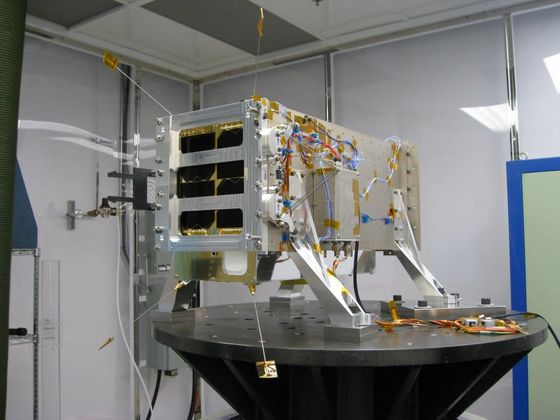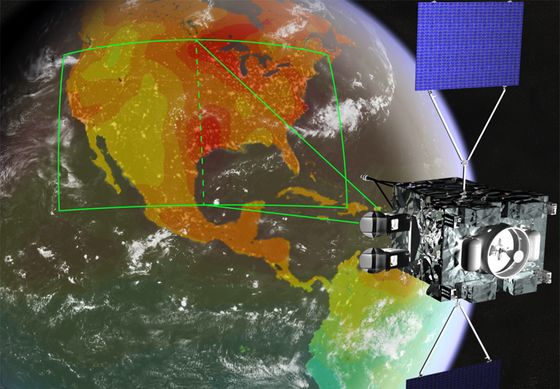Satellites that watch atmospheric carbon dioxide and methane gas from above the sky

It is well known that greenhouse gases such as carbon dioxide and methane gas are the main causes of global warming, but precise observations using artificial satellites are necessary to know where these gases came from. Essential. The American scientific magazine
Meet the Satellites That Can Pinpoint Methane and Carbon Dioxide Leaks-Scientific American
https://www.scientificamerican.com/article/meet-the-satellites-that-can-pinpoint-methane-and-carbon-dioxide-leaks/
◆ TROPOMI
' TROPOspheric Monitoring Instrument (TROPOMI) ' is an earth observation satellite launched by the European Space Agency on October 3, 2017. TROPOMI, which captures ultraviolet rays, visible light, infrared rays, etc., and observes an area of approximately 2600km x 7km on the surface every second, creates an air pollution map that covers the entire globe in 24 hours.
About TROPOMI, which can create a detailed world map of carbon dioxide, carbon monoxide, nitrogen oxides and various other harmful substances, ESA Earth Observation Director Joseph Ashbacher called `` European Milestone '' I praised it.
The air pollution map created by TROPOMI looks like this.
RT @ESA_EO:. @ Copernicus # Sentinel5p might be new to the family but that doesn't mean it's not keeping up with the others! Here's an animation showing the levels of #AirPollution on our planet: https://t.co/ BiMjxDC6M9 pic.twitter.com/h8awxTHhin
— TROPOMI (@tropomi) January 15, 2018
In June 2019, when a volcano erupted on the Thunder Public Bank in the Kuril Islands, a map that tracks sulfur dioxide rolled up in the atmosphere is also released.
Hope You Enjoyed We #Fireworks Displays During The American 4Th Of July Celebrations! Well, #TROPOMI Also Saw Some Impressive Fireworks In The Sky Thanks To Massive Eruptions Of The #Raikoke Volcano In The Sea Of Okhotsk. # SO2 Swirls In The Upper Atmosphere Above North America.pic.twitter.com/TVElKMEX5K
— TROPOMI (@tropomi) July 6, 2019
◆ Claire
Claire is a proof-of-concept satellite launched by Montreal, Canada-based startup GHGSat . Claire, named after a baby given by a GHGSat employee, is responsible for observing methane gas in the atmosphere in conjunction with satellites such as Tropomi. Claire has a small sensor unit that has only a microwave oven size, but its accuracy is surprisingly detailed, and it can detect even methane gas leaks from specific places rather than air pollution.

An example of this is the following image, where a large amount of methane gas was released from the Rom Phang Nga Dam in Cameroon. It is a hydroelectric power generation of a dam that seems to be clean because it does not burn fossil fuel, but a large amount of methane gas is generated due to decomposition of forest trees submerged in water

GHGSat CEO Stefan Germain said, “Claire is primarily focused on industrial applications, but we are also interested in working with regulators. I hope it will be useful for the environment, 'he said, and expressed his willingness to engage in environmental protection.
◆ Bluefield CubeSat
The

Bluefield has not yet launched a satellite into space, but is planning to launch it for the first time in 2020. “In the near future, NASA and other space agencies will outsource their operations to private companies,” said Bluefield CEO Yotam Ariel, and talked about the prospects for space development with a cost-effective weapon.
◆ GeoCarb
NASA, on the other hand, started development of GeoCarb that can monitor carbon dioxide and methane gas more powerfully in response to the success of the on -orbit carbon observation satellite (OCO-2) launched in 2014. We are preparing for the first launch.
Unlike TROPOMI and Claire, which monitor the entire earth, GeoCarb observes the atmosphere of the Americas from a geostationary orbit about 35,800 km above the Americas. By monitoring the North African continent including the United States, the world's second largest carbon dioxide emitting country, and the South America continent where the Amazon rainforest is located, the weather and greenhouse gases such as El Niño and La Niña are monitored. It is possible to explore the relationship.

NASA pointed out, “Methane gas leakage from natural gas production is damaging from US $ 5 billion (about 541.8 billion yen) to $ 10 billion (about 1,83.7 billion yen) in the US industry” He stated that GeoCarb, which is expected to be useful, is expected to play an active role in both environmental protection and economy.
Related Posts:
in Hardware, Posted by log1l_ks







